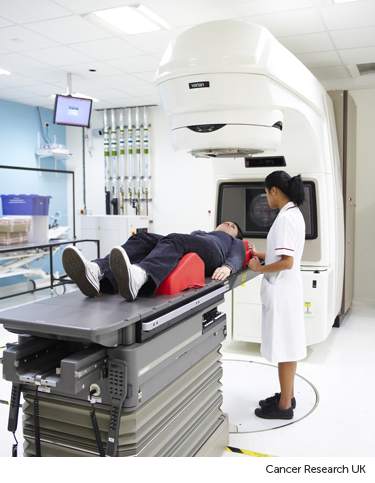Radiotherapy for spinal cord compression
Spinal cord compression means that cancer is pressing on or near the spinal cord. It is also called metastatic spinal cord compression (MSCC). Metastatic means that the cancer has spread to the spine from another part of the body.
The pressure from the cancer can cause symptoms such as:
- pain
- weakness or tingling in your legs
- loss of bladder or bowel control
- changes to sensation in your body, such as pins and needles, and numbness
If the pressure on the spinal cord continues, it can permanently damage your spinal cord nerves. So it is very important to treat it quickly.

When you have radiotherapy
You might have radiotherapy:
- to help control pain and prevent spinal cord compression
- to relieve pressure on your spinal cord if you have spinal cord compression – this lowers the chance of long term nerve damage
- after surgery to remove cancer from your spine
Types of radiotherapy
You usually have external radiotherapy to treat a spinal cord tumour. External radiotherapy destroys cancer cells by using radiation aimed at a cancer from a machine.
A small number of people with spinal cord compression might have a type of external radiotherapy called stereotactic radiotherapy. Stereotactic radiotherapy gives high doses of radiation from different angles around the body. This means that your treatment team can direct a very high dose of radiation to the tumour and a much lower dose to the tissues around it.
Stereotactic radiotherapy isn’t suitable for everyone. Your doctor can tell you more about this treatment and whether it is suitable for you.
How radiotherapy can help
Radiotherapy aims to shrink the cancer and relieve the pressure on the spinal cord. This can lower the chance of long term nerve damage.
Your doctor will prescribe painkillers if you need them. You also have steroids because they can reduce swelling. And help to relieve the pressure on the spinal cord.
How you have radiotherapy
You are usually admitted to hospital urgently for radiotherapy for spinal cord compression. You stay in hospital while you have the treatment.
You have the radiotherapy as a single treatment or a series of daily treatment sessions called fractions. Normally you have one a day. But occasionally you may have 2 fractions a day, for example, just before a weekend.
You might have a plastic mould made to keep you still while you have treatment. This depends on what part of the spine has cancer. You're likely to have a plastic mould made if the cancer is in the upper part of your spine.
Having treatment
You have a CT planning scan so the treatment team can plan exactly where to give the radiotherapy.
Spinal cord compression needs treatment urgently. So the doctor will try to fit you in for radiotherapy as soon as possible. This might mean you have the planning scan and treatment on the same day or weekend.
Usually a hospital porter will take you from the ward to the radiotherapy department.
The radiotherapy machine is called a linear accelerator. The therapeutic radiographers will gently transfer you to the radiotherapy couch. Then they will help you get into the right position.

Your radiographers then leave the room so they are not exposed to the radiation. You will be alone for a few minutes. But your radiographers can see and hear you at all times.
It is important that you keep still and breathe normally. Sometimes there may be a delay in starting the radiotherapy. This is because the radiographers take an x-ray before treatment to check your position.
You can't feel the radiotherapy. It doesn’t hurt but you might find it uncomfortable to lie still during the treatment. The radiotherapy couch can be quite hard. You can ask your doctor or specialist nurse if you can take a painkiller half an hour beforehand, if you think it might help.
Treatment results
You might see an improvement in your symptoms within a few days of starting radiotherapy. This can depend on how severe your symptoms are.
The treatment usually helps to relieve:
- pain
- weakness in your legs
- loss of bladder or bowel control
Possible side effects
Side effects of radiotherapy for spinal cord compression are usually mild. The effects tend to come on gradually as you go through your treatment course. They might last for a week or two after the treatment has finished. They can include:
-
tiredness
-
reddening or darkening of the skin, or itching in the treatment area
-
feeling sick
-
diarrhoea
-
a worsening of pain for 1 to 2 days
Speak to your team about any side effects that you have. There are lots of things they can do to help, such as giving you anti sickness medicines.



